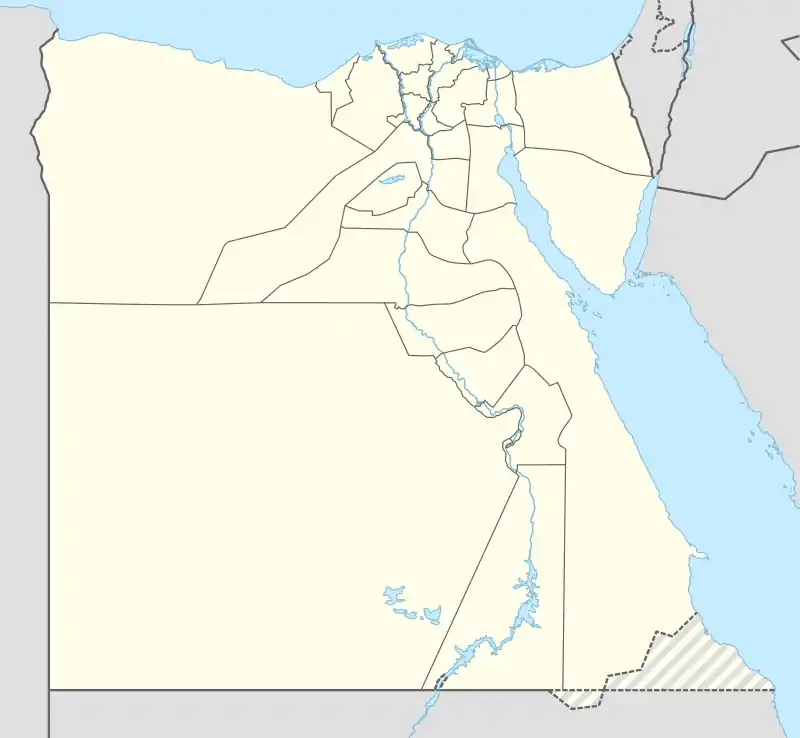KV64
KV64 is the tomb of an (as yet) unknown Eighteenth Dynasty burial in the Valley of the Kings, near Luxor, Egypt that was re-used in the Twenty-second Dynasty for the burial of the priestess Nehmes Bastet, who held the office of "chantress' at the temple of Karnak. The tomb is located on the pathway to Tomb KV34 (for Thuthmosis III) in the main Valley of the Kings. KV64 was excavated in 2011 and described in 2012 by Dr. Susanne Bickel and Dr. Elina Paulin-Grothe of the University of Basel.[1][2]
| KV64 | |||
|---|---|---|---|
| Burial site of Singer [the Lady] Nehmes Bastet | |||
 KV64 | |||
| Coordinates | 25°44′24.6″N 32°36′04.7″E | ||
| Location | East Valley of the Kings | ||
| Discovered | 2011 | ||
18th Dynasty burial
Originally, the tomb was carved out and used for a burial during the Eighteenth Dynasty. Rubble covering the floor of the tomb when discovered, contained materials dating back to the looted eighteenth dynasty burial. The rubble included the mummy of a woman from that dynasty, two heads of canopic jars, and some rare glassware. The finds also included a partial wooden label bearing the name of Princess Satiah. It is not known whether the label belongs to the original woman for whom the tomb was created.[3]
22nd Dynasty burial
Upon entering the tomb in 2011, the excavators discovered a wooden coffin and a stela placed near the wall that was facing the head of the coffin. Both were placed atop a deep layer of rubble. The mummy in the coffin belongs to a priestess, the "Chantress of Amun", Nehemesbastet. She was the daughter of Nakhtefmut, a priest of Amun who held the office of the "Opener of the Doors of Heaven" at Karnak, an important Ancient Egyptian temple during that dynasty. The wooden stela shows Nehemesbastet worshiping before a composite deity with attributes of both a sun-god and the god Osiris.[3]
Previous use of KV64 designation
"KV64" (with quotation marks) had been employed as a tentative designation in reference to an anomaly detected by the use of ground-penetrating radar by the Amarna Royal Tombs Project (ARTP),[4] led by Nicholas Reeves, during the autumn of 2000. Although a likely location of a tomb, excavation was not conducted, so the tomb remained uncovered at that time.[5]
External links
- Amarna Royal Tombs Project (ARTP): KV64
- "Rare tomb of woman found in Egypt Valley of Kings". The Guardian. London. 2008-01-23. Archived from the original on January 18, 2012. Retrieved 2012-01-15.CS1 maint: unfit URL (link)
Notes
- S. Bickel & E. Paulin-Grothe, “KV 64: two burials in one tomb,” Egyptian Archaeology, vol. 41, pp. 36–40, 2012.
- "New archaeological discovery at the Valley of the Kings - Ancient Egypt - Heritage - Ahram Online". english.ahram.org.eg. Retrieved 2018-02-26.
- Susanne Bickel, Princesses, Robbers, and Priests - The unknown side of the Kings' Valley, Presentation at a conference at the Museo Egizio in Turin, Italy, October 14 2017, Online; KV 64 is discussed at 27:30 onward
- ARTP website Archived 2008-10-10 at the Wayback Machine; possible presence of a tomb at this location
- "Another New Tomb in the Valley of the Kings? - Archaeology Magazine Archive". archive.archaeology.org. Retrieved 2018-02-26.